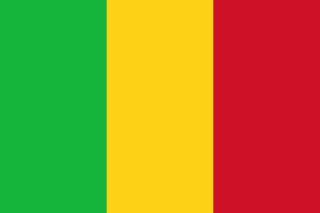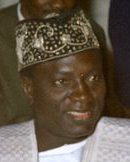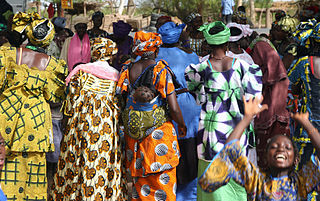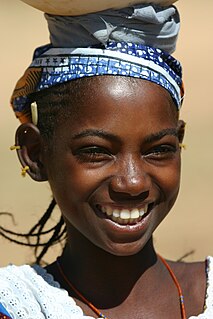Related Research Articles
Bambara, also known as Bamana or Bamanankan is a lingua franca and national language of Mali spoken by perhaps 15 million people, natively by 5 million Bambara people and about 10 million second-language users. It is estimated that about 80 percent of the population of Mali speak Bambara as a first or second language. It has a subject–object–verb clause structure and two lexical tones. The native name bamanankan means "the language of greats, people who reject the religion of Islam", as opposed to speakers of Dyula, who are Muslim.

Mali, officially the Republic of Mali, is a landlocked country in West Africa. Mali is the eighth-largest country in Africa, with an area of over 1,240,000 square kilometres (480,000 sq mi). The population of Mali is 19.1 million. 67% of its population was estimated to be under the age of 25 in 2017. Its capital and largest city is Bamako. The sovereign state of Mali consists of eight regions and its borders on the north reach deep into the middle of the Sahara Desert. The country's southern part is in the Sudanian savanna, where the majority of inhabitants live, and both the Niger and Senegal rivers pass through. The country's economy centres on agriculture and mining. One of Mali's most prominent natural resources is gold, and the country is the third largest producer of gold on the African continent. It also exports salt.

This article is about the demographic features of the population of Mali, including population density, ethnicity, education level, health of the populace, economic status, religious affiliations and other aspects of the population.

The Dogon are an ethnic group indigenous to the central plateau region of Mali, in West Africa, south of the Niger bend, near the city of Bandiagara, and in Burkina Faso. The population numbers between 400,000 and 800,000. They speak the Dogon languages, which are considered to constitute an independent branch of the Niger–Congo language family, meaning that they are not closely related to any other languages.

Modibo Keïta was the first President of Mali (1960–1968) and the Prime Minister of the Mali Federation. He espoused a form of African socialism.
Mali is a multilingual country. The languages spoken there reflect ancient settlement patterns, migrations, and its long history. Ethnologue counts more than 80 languages. Of these, French is the official language and Bambara is the most widely spoken. All together 13 of the indigenous languages of Mali have the legal status of national language.

Bandiagara is a small town and urban commune in the Mopti Region of Mali. The name translates roughly to "large eating bowl"—referring to the communal bowl meals are served in. Mainly on its Bandiagara Escarpment it has about 2,000 speakers of the vibrant Bangime language, an isolate used mainly as an anti-language; it has the highest point of the country.
Adama Drabo was a Malian filmmaker and playwright.
Yambo Ouologuem was a Malian writer. His first novel, Le devoir de violence, won the Prix Renaudot. He later published Lettre à la France nègre (1969), and Les mille et une bibles du sexe (1969) under the pseudonym Utto Rodolph. Le devoir de violence was initially well-received, but critics later charged that Ouologuem had plagiarized passages from Graham Greene and other established authors. Ouologuem turned away from the Western press as a result of the matter, and remained reclusive for the rest of his life.

Articles related to Mali include:

The Tellem were the people who inhabited the Bandiagara Escarpment in Mali between the 11th and 16th centuries CE. The Dogon people migrated to the escarpment region around the 14th century. In the rock cells of this red cliff, clay constructions shelter the bones of the Tellem as well as vestiges witnessing their civilization, well before that of the Dogons.

Education in Mali is considered a fundamental right of Malians. For most of Mali's history, the government split primary education into two cycles which allowed Malian students to take examinations to gain admission to secondary, tertiary, or higher education. Mali has recently seen large increases in school enrollment due to educational reforms.

The culture of Mali derives from the shared experience, as a colonial and post-colonial polity, and the interaction of the numerous cultures which make up the Malian people. What is today the nation of Mali was united first in the medieval period as the Mali Empire. While the current state does not include areas in the southwest, and is expanded far to the east and northeast, the dominant roles of the Mandé peoples is shared by the modern Mali, and the empire from which its name originates from.

The status and social roles of women in Mali have been formed by the complex interplay of a variety of traditions in ethnic communities, the rise and fall of the great Sahelien states, French colonial rule, independence, urbanisation, and postcolonial conflict and progress. Forming just less than half Mali's population, Malian women have sometimes been the center of matrilineal societies, but have always been crucial to the economic and social structure of this largely rural, agricultural society.
The Tebul language, also known as Tebul Ure, is a Dogon language spoken in Mali by the Tebul U. It was first reported under this name online by Roger Blench, who erroneously reported that it appears to be the same as a language called Oru Yille in the literature. This mistaken name instead means 'two words' in the Tebul language.
Tebul Sign Language is a village sign language of the village of Uluban in the Dogon region of Mali, among speakers of Tebul Dogon.
A village sign language, or village sign, also known as a shared sign language, is a local indigenous sign language used by both deaf and hearing in an area with a high incidence of congenital deafness. Meir et al. define a village sign language as one which "arise[s] in an existing, relatively insular community into which a number of deaf children are born." The term "rural sign language" refers to almost the same concept. In many cases, the sign language is known throughout the community by a large portion of the hearing population. These languages generally include signs derived from gestures used by the hearing population, so that neighboring village sign languages may be lexically similar without being actually related, due to local similarities in cultural gestures which preceded the sign languages. Most village sign languages are endangered due to the spread of formal education for the deaf, which use or generate deaf-community sign languages, such as a national or foreign sign language.
Douentza Sign Language, or Dogon Sign Language is a community sign language spoken in Douentza and neighboring communities in the Dogon country in Mali. It is unknown how similar it may be to the nearby village sign language, Tebul Sign Language, but it may be unrelated to another sign language of the Dogon region, Berbey Sign Language. As of 2013, there is no school for the deaf in the area, but one is planned; the introduction of American Sign Language as the language of instruction may affect Douentza Sign. A video corpus has been collected by the Max Planck Institute for Psycholinguistics to document the pre-contact form of the language.
Bouakako Sign Language, known in French as la Langue des Signes Bouakako (LaSiBo), is an emerging village sign language in the village of Bouakako, 6 km to the west of the town of Hiré in southern Ivory Coast. LaSiBo has been used by several generations of deaf people, most of whom are related. Many of the hearing community, who speak Yocoboué Dida, know something of the language as well, and some are fluent. The vocabulary is somewhat variable between speakers, suggesting that the language is still quite young. Based on the age of the oldest deaf signer, it is probably at least 50 years old.
Moussa Timbiné is a Malian politician representing Rally for Mali. He became President of the National Assembly of Mali on 11 May 2020 but was deposed on 18 August 2020 during the 2020 Malian coup d'état. He had been a member of the National Assembly since 2013.